RISING STORM - THE IMPERIAL JAPANESE NAVY AND
CHINA
1931-1941
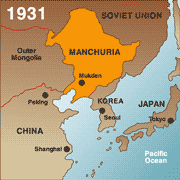 Manchuria in 1931
Manchuria in 1931
The Beginning of War in Asia- "The Mukden
Incident"
and the Conquest of Manchuria - 1931
© 2012 Bob Hackett, Sander Kingsepp and Anthony Tully
Revision 1
Geographically situated between China, Russia and Japan, Manchuria has been of strategic importance throughout its long history. In antiquity, parts of Manchuria were controlled by various Chinese and Korean kingdoms. In 1213, the Mongol emperor Genghis (Chingiss) Khan established the state of what later became known as Manchuria. In the early 15th century, after expulsion of the Mongols from Beijing, the Ming Empire took control of Manchuria. In 1644, the Manchus took Beijing, overthrew the Ming Dynasty and established Qing Dynasty rule over all China. In 1689, the Treaty of Nerchinsk fixed the boundary with Russian Siberia. In 1858, under the Treaty of Aigun, the Qing Empire was forced to cede Manchuria to Russia, north of the Amur. In 1860, the Russians established control over the northern part of Manchuria under the Treaty of Peking (Beijing). As a result of the Treaties of Aigun and Peking, China lost access to the Sea of Japan. Disputes over Manchuria and Korea led to the Russo-Japanese War of 1904 to 1905. After 1905, victorious Japan replaced Russian influence in the southern half of Manchuria.
In the 20th century, Japan sees Manchuria as an unlimited source of raw materials such as coal, iron ore and minerals and its fertile soil as suitable for agriculture. Japan also sees Manchuria as a buffer state against encroachments of its interests by the Soviet Union from Siberia.
18 September 1931: The "Mukden Incident."
Liutiaohu, about 25 miles from Mukden (now Shenyang), capital of Manchuria. Japanese soldiers detonate an explosive on the Japanese-owned Southern Manchurian Railway. Chinese soldiers retaliate with gunfire. The Japanese Kwantung Army reinforces their troops and settles the conflict.
19 September 1931:
The Japanese continue north, bomb Mukden and several towns in south Manchuria and then occupy Mukden. The Kwantung Army seizes banks, utilities and municipal administration centers.
21 September 1931:
China appeals to the League of Nations. The League sends British Lord V. A. G. R. Bulwer-Lytton, 2nd Earl of Lytton, to Manchuria to lead a Commission to investigate.
29 September 1931:
The USSR declares its neutrality on the "Mukden Incident."
January 1932:
Shanghai. Rear Admiral (later Admiral) Shiozawa Koichi (32)(former CO of FURUTAKA), flying his First China Expeditionary Fleet flag in the 11th Gunboat Squadron's ATAKA, is the senior Japanese naval officer present. Since the Japanese garrison consists of the Shanghai Special Naval Landing Force (SNLF) of about 2,500 troops, Shiozawa is in complete control of IJN forces also consisting of light cruisers OI and HIRADO, minelayer (ex-armored cruiser) TOKIWA, destroyers URAKAZE, HAGI, FUJI, SUSUKI and TSUTA and gunboat KATATA.
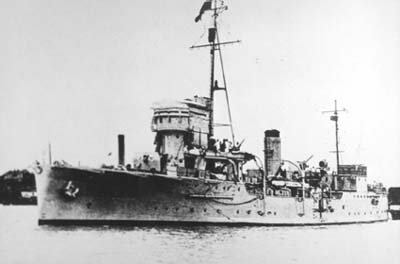 Flagship ATAKA
Flagship ATAKA
20 January 1932:
The Chinese boycott the import and sale of Japanese goods in protest over the Mukden Incident in the preceding weeks. The Japanese retaliate by burning factories and shops. The Japanese Consul-General demands that Shanghai’s Mayor Wu T'ieh-ch'eng dissolve all anti-Japanese organizations, pay compensation and end anti-Japanese agitation. Rear Admiral Shiozawa knows fleet oiler/seaplane tender NOTORO will arrive soon, so he backs Japanese demands on the mayor.
28 January 1932: The "First Shanghai Incident":
At dawn, the Japanese men-of-war at Shanghai take up stations alongside Japanese wharves and other interests. ATAKA comes alongside the Nippon Yusen Kaisha (NYK) wharf adjacent to the Japanese consulate. Tender NOTORO arrives at Shanghai.
Although Mayor Wu gives in before the deadline, other foreign settlements mobilize as does Admiral Shiozawa. The Shanghai SNLF is dispatched to evict two divisions of the Chinese 19th Route Army from Shanghai. The Japanese attack the forts of Wusong and Chapei (Zhabei). That night, NOTORO's seaplanes drop flares to frighten the opposition. The Chinese think they are being attacked. and retaliate. There are many Japanese casualties.
29 January 1932:
Huangpu (Whangpoa) River, Shanghai. Rear Admiral Shiozawa orders NOTORO, anchored in the Yangtze River, to launch an aerial attack on Chinese military positions in Shanghai. Captain Mitsunami dispatches his E1Y3 floatplanes in foggy weather. They make ten low-level attacks on the old Chapei sector, artillery positions outside the city and an armored train in the North Railway Station. The attacks result in a heavy loss of civilian lives and property. The Chinese unify against the Japanese who are unable to capture Shanghai. Large-scale fighting breaks out. The IJN brings its heavy naval guns to bear on the Chinese.
1 February 1932:
IJN CarDiv 1's HOSHO and DesDiv 3 arrive off the mouth of the Yangtze River and support operations in the vicinity. The Imperial Army (IJA) is called in to assist the badly outnumbered Shanghai SNLF. By the end of the month, IJA troops number 50,000 men under General Shirakawa Yoshinori. [1]
That same day, United States Secretary of State Henry L. Stimson and the British call on China and Japan to observe the "Pact of Paris and the Resolution of the League of Nations of 9 December 1931” to cease the conflict and fighting in Shanghai.
5 February 1932:
Shingu area. Two attack bombers escorted by three Nakajima Type 3 bi-plane fighters from HOSHO engage in several aerial battles with Chinese Air Force (CAF) fighters. This marks the first recorded aerial battle in the history of Japanese air forces.
7 February 1932:
A portion of CarDiv 1's KAGA and HOSHO's aircraft land at the newly established Kunda airfield in Shanghai and support ground operations.
22 February 1932:
Three carrier attack bombers from KAGA escorted by six Type 3 fighters engage a CAF Boeing 218 bi-plane fighter piloted by American volunteer Robert Short. He shoots down one bomber, but is overwhelmed and shot down.
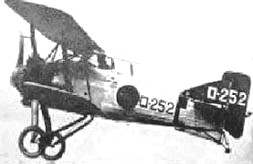
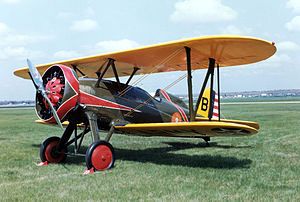 IJN Nakajima Type 3 A1N carrier fighter and Boeing B-218 (in U.S. markings) fighter
IJN Nakajima Type 3 A1N carrier fighter and Boeing B-218 (in U.S. markings) fighter
26 February 1932:
Nine carrier attack bombers from KAGA escorted by six fighters from HOSHO attack the CAF airfield at Hangchow. On the return flight, the Japanese are engaged by five CAF fighters, of which three are shot down.
1 March 1932: The Fall of Manchuria:
Shirakawa's troops encircle the Chinese 19th Route Army and force a Cease-Fire. That same day, the Japanese establish the puppet government of Manchukuo (Manchuria). They make the last emperor of China, Henry Pu Yi, (Puyi), ruler of Manchukuo. [2]
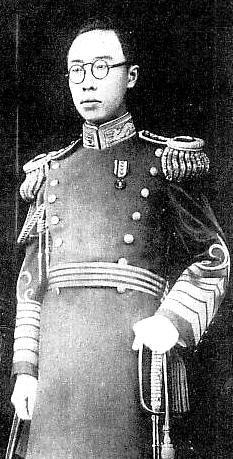 Henry PuYi as Emperor Kang-de
Henry PuYi as Emperor Kang-de
15 April 1932:
Pu Yi formally establishes the Manchukuo Imperial Navy and also assumes the role of supreme commander. The flagship of his fleet is HAI WEI (formerly IJN MOMO class destroyer KASHI). However, the IJN 3rd (North) China Fleet maintains coastal defense for Manchukuo.
1 December 1932:
Captain (later Rear Admiral) Kuwabara Torao (37) assumes command.
25 February 1933: Japan withdraws from the League of Nations.
Geneva, Switzerland. The Lytton Commission reports to the League that Japan violated Chinese sovereignty and should return Manchuria to China. At a Special Assembly, 40 nations vote that Japan should withdraw. Only Japan votes against it. Instead of returning Manchuria, Japan instructs its representative Matsuoka Yosuke (later Foreign Minister) to walk out of the League. After withdrawing from the League, Japan decides she also will no longer abide by restrictions such as the Washington Treaty of 1922 and the London Treaty of 1930 that impose limitations on the number and size of her warships.
The 1931 Manchurian conflict thus begins a new war in Asia and plants the seeds that erupt in 1937 into the Second Sino-Japanese War
and further bloom into the Pacific War in December 1941.
Authors' Note:
[1] On 29 April 1932, at an IJA celebration of Emperor Hirohito's birthday in Shanghai, General Shirakawa is seriously injured by a bomb
set off by a Korean activist and later dies of his wounds.
[2] Pu Yi was given the name "Henry" by his English-language teacher. In China, as the last emperor, he was known as Emperor Hsuan-Tung. In 1934, Pu Yi was officially crowned Emperor of Manchukuo under the reign title Kang-de.
-Bob Hackett, Sander Kingsepp and Anthony Tully
Back to Rising Storm Page









